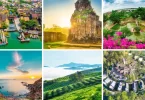Introduction to My Son Sanctuary
My Son Sanctuary, located in Duy Phu Commune, Duy Xuyen District, Quang Nam Province, is one of Vietnam’s most prominent cultural heritage sites. This ancient complex of Cham Pa temples was constructed between the 4th and 13th centuries. Recognized as a UNESCO World Cultural Heritage Site in 1999, My Son holds exceptional historical, cultural, and artistic value in Southeast Asia, comparable to Angkor Wat (Cambodia) and Borobudur (Indonesia).
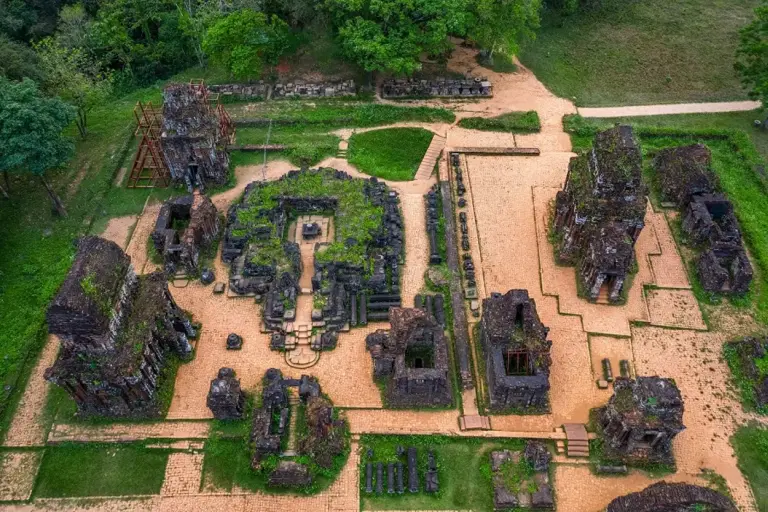
Panoramic view of My Son Sanctuary.
History and Development
- Origins: My Son Sanctuary was initiated by King Bhadravarman in the 4th century as a place of worship for Shiva, the supreme deity of Hinduism.
- Development Period: Over the centuries, successive Cham kings expanded and added more temples with distinctive architectural styles, reflecting a blend of cultures and beliefs.
- Destruction: While war and time have significantly damaged many structures, over 32 temples remain intact or have been restored.
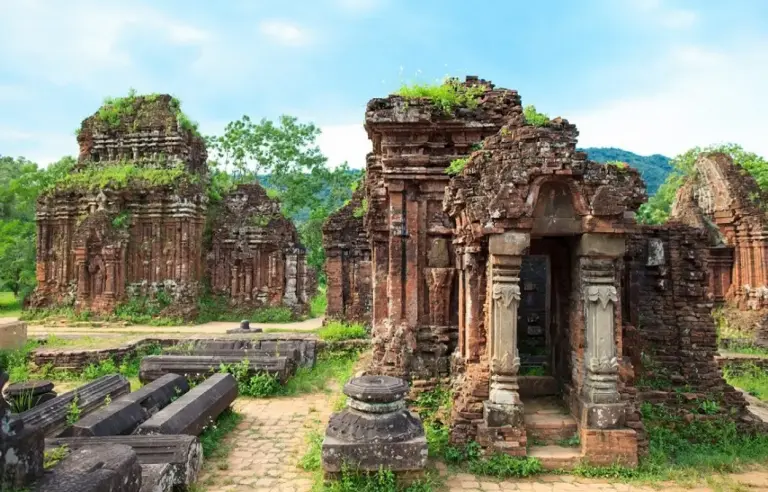
My Son Sanctuary with mysterious ancient architecture.
Unique Architecture
- Building Materials: The temples were constructed using baked bricks and sandstone with a dry masonry technique, creating a mystery that has yet to be fully deciphered.
- Structure of the Temples:
- Base: Represents the earthly realm.
- Body: Symbolizes the spiritual world and human existence.
- Top: A representation of the divine and its connection to the universe.
- Layout: The temples are grouped into clusters, each featuring a main temple and auxiliary towers, typically facing east – the abode of the gods.

My Son Sanctuary with mysterious ancient architecture.
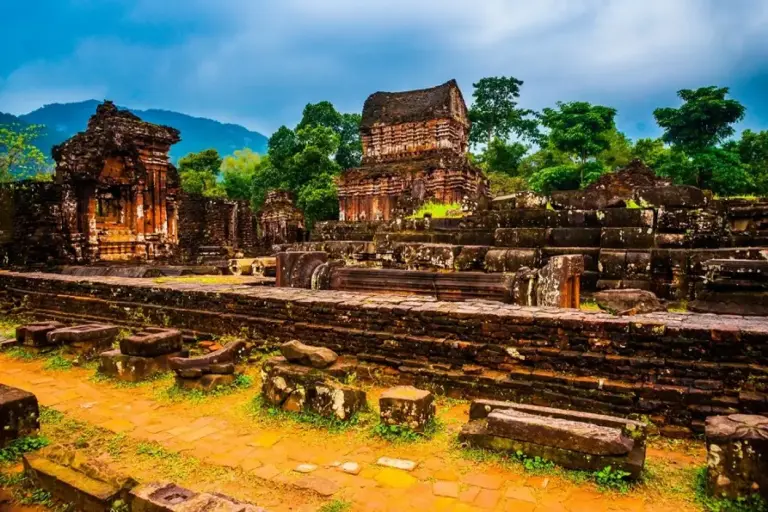
Explore centuries-old ancient architecture at My Son.
Highlights of My Son Sanctuary
- Historical and Artistic Significance:
- My Son preserves nearly nine centuries of Cham architectural and artistic heritage.
- The bas-reliefs and sculptures depict stories from Hindu mythology, illustrating the Cham people’s cultural and religious life.
- Traditional Festivals:
- Katê Festival: Held annually in the 7th lunar month, this event offers visitors a chance to experience traditional Cham culture.
- Cham Dance Performances:
- The graceful Apsara dances bring to life the beauty of Cham culture through music and performance art.
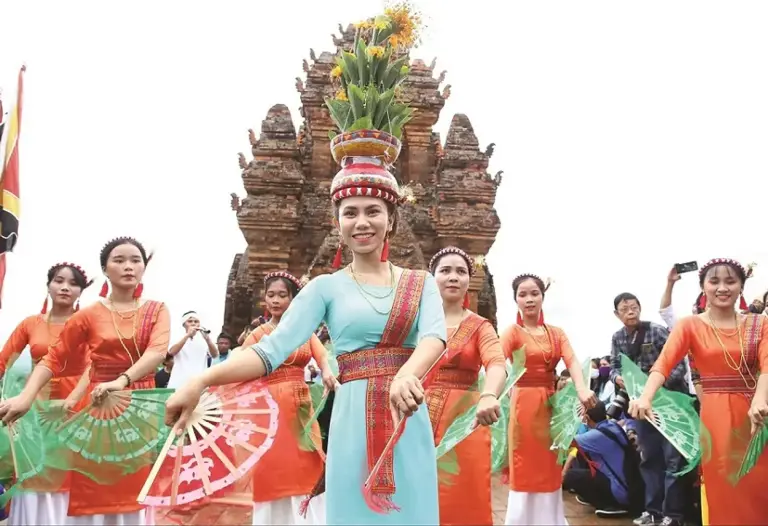
Traditional Kate festival of the Cham people.
How to Get to My Son Sanctuary
- From Da Nang (69 km):
- Bus: Take Route No. 06 from the city center, operating between 5:30 AM and 5:00 PM.
- Motorbike/Car: Follow National Highway 1A to Nam Phuoc, then take DT537.
- Taxi: Convenient and safe but more expensive.
- From Hoi An (40 km):
- Motorbike: Cost-effective and convenient.
- Private Service: Ideal for groups looking to save time.

Remember to admire this ancient road.
Best Time to Visit
- February to April: Mild and pleasant weather, perfect for exploring.
- May to August: Sunny but avoid midday visits due to high temperatures.
Entrance Fees and Opening Hours
- Vietnamese Visitors: 3-4$/person.
- Foreign Visitors: 4-5$/person.
- Opening Hours: 6:30 AM – 5:30 PM daily.
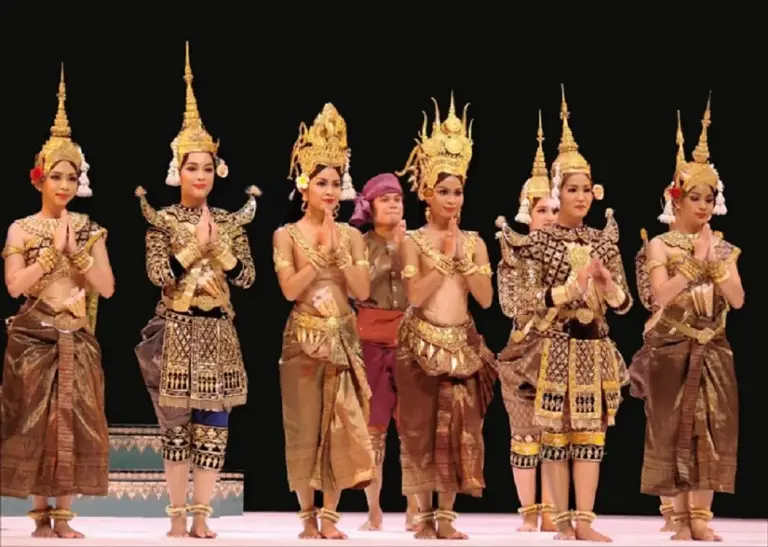
Be enchanted by the Apsara dance.
Tips for Exploring My Son Sanctuary
- Suggested Itinerary:
- Morning: Explore clusters A, B, and C, which feature numerous temples and bas-reliefs.
- Noon: Rest and enjoy lunch at nearby eateries.
- Afternoon: Watch Cham dance performances and take photos.
- Preparation:
- Wear comfortable shoes for walking.
- Bring water and a hat/cap to protect against the sun.
- Notes:
- Avoid touching artifacts or climbing on structures to help preserve the heritage.

When coming to My Son, remember to choose from February to August.
Discover More in Quang Nam
After visiting My Son, continue your journey by exploring Hoi An, An Bang Beach, or Thanh Ha Pottery Village to dive deeper into the cultural richness of Quang Nam.
My Son Sanctuary is not only an ideal destination to learn about history but also a place where visitors can immerse themselves in the unique cultural and artistic beauty of the ancient Cham Pa civilization. Plan your visit and experience it today!
Frequently asked questions about My Son tourism
1. Does My Son Sanctuary have anything special that attracts tourists?
Yes, My Son Sanctuary stands out with its unique architecture and profound cultural values. This place used to be the religious center of the Champa kingdom, where Linga and Shiva were worshiped, attracting many tourists to explore.
2. How much is the entrance fee to My Son Sanctuary for tourists?
The entrance fee to My Son Sanctuary for foreign tourists is about $6/person. If there is a tour guide, the ticket price can be up to $11/person. Vietnamese tourists can buy tickets for $4/person.
3. When is the best time to visit My Son Sanctuary?
The best time to visit My Son Sanctuary is from February to April, after Tet. At this time, the weather is cool, convenient for traveling and taking photos, helping you enjoy the beauty of the relics to the fullest.
4. What means of transport are there to get to My Son Sanctuary from Da Nang?
There are many ways to get to My Son Sanctuary from Da Nang, including bus, motorbike or taxi. Bus route 06 operates from 5:30 am to 5 pm, fares range from0.3 to 1.1$, while taxis are convenient but can be more expensive.
5. Is there anything special about the history of the formation of My Son Sanctuary?
My Son Sanctuary was built in the 4th century by King Bhadravarman I, with development through the Champa dynasties. This place has witnessed many historical events, from the rise and fall of the kingdom to its recognition as a World Cultural Heritage in 1999.
6. What activities can you participate in when visiting My Son Sanctuary?
Visitors can take part in many interesting activities at My Son Sanctuary, including visiting the temples, experiencing Apsara dance, participating in the Cham Kate festival, and taking photos in traditional Champa costumes amidst the ancient scenery.




